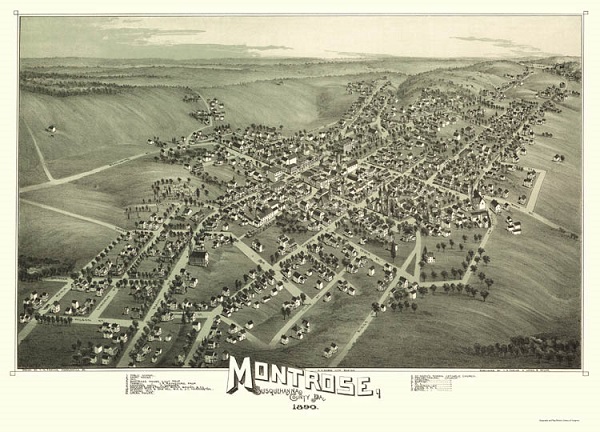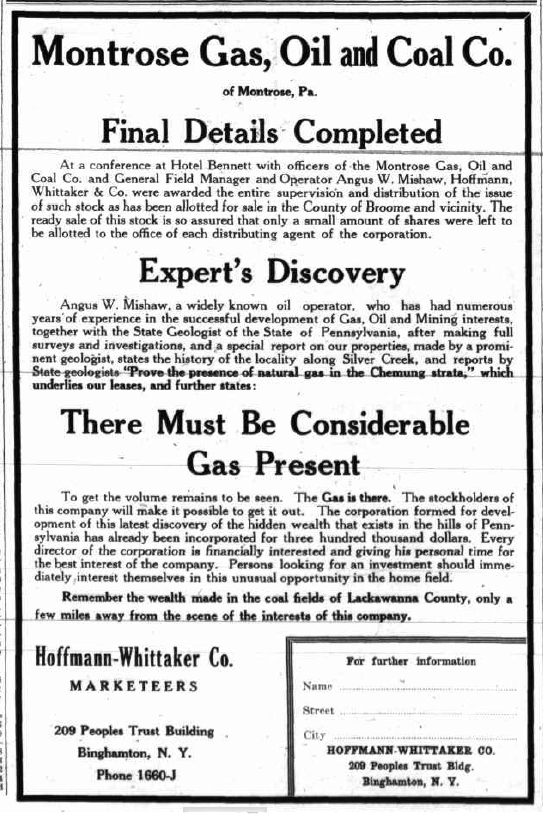The earliest U.S. petroleum exploration companies learned to look for natural seeps. A decade before the Montrose Gas, Oil and Coal Company organized in 1920, natural gas was known to seep from the ground in Susquehanna County, Pennsylvania.
“Natural Gas flowing from a hole near the back of the N. Philip Wheaton farm in Franklin township, seven miles from Montrose, has been used by the family for the past fifteen years for lighting and stoves,” noted a 1910 article in the Montrose Democrat.
Montrose, established in 1812 in the northeastern corner of Pennsylvania near the New York border, was known for its quarry sites, which yielded a blue sandstone popular as an architectural and building stone.

An aero-view or “bird’s eye” map of Montrose, Pennsylvania, by Thaddeus Mortimer Fowler depicted this Susquehanna County community in 1890. The area’s quarries produced a durable blue sandstone today known as Pennsylvania Bluestone.
In late 1920, Montrose Gas, Oil and Coal launched plans to drill for natural gas to serve markets just to the north in Binghamton, New York, and to the south in Scranton. Capitalized at $300,000, the company offered investors shares for $10 each through an expansive newspaper campaign.
“One good gas well, yielding an average of 5,000,000 cubic feet a day would mean an annual yield of $565,750,” proclaimed advertisements in the Scranton Republican. Many readers remembered the economic boom from an earlier Pennsylvania natural gas field (see Natural Gas is King in Pittsburgh).
Before the end of 1921, Montrose Gas, Oil and Coal had sold enough common stock to finance drilling near Franklin Fork, a few miles from Montrose. The company’s cable-tool rig found natural gas at a depth of just 200 feet. Production records cannot be found.

The Montrose Gas, Oil and Coal Company natural gas well of 1921. Although the Pennsylvania company failed, today beneath Susquehanna County lies the Marcellus Shale with an estimated 500 trillion cubic feet of natural gas. Photo courtesy of Susquehanna Historical Society, Horgan Collection.
“Many of the stockholders of the company residing in this immediate vicinity drove to the well as soon as the news was circulated in order to verify with their eyes what it seemed could hardly be true,” noted one contemporary account.
“A piece of tow (rope) was lighted and thrown down the ten-inch pipe, with the result that the lighted gas would flame up five feet in the air,” the report continued. “The flow has been steady ever since.”
Prospects for the company’s future looked good.
In April 1922, Montrose Gas, Oil and Coal stock still traded. As late as November, the company was considered viable and had plans to expand drilling operations in the field…if more funding could be secured.
However, the company soon disappeared from records. The Pennsylvania Internet Record Imaging System/Wells Information System, available online, may have further details.

Although the company drilled a successful natural gas well, newspaper advertisements to raise capital did not attract enough investors.
Today beneath Susquehanna County lies the Marcellus Shale with trillions cubic feet of natural gas, stretching through parts of New York State, Pennsylvania, Ohio and West Virginia.
In 2012 alone Susquehanna County landowners received $300 million in lease royalties. Modern recovery techniques such as hydraulic fracturing (fracking) and horizontal drilling have enabled extraction of this trapped gas.
But for Montrose Gas, Oil and Coal Company, such technology was years away. The company’s stock certificates may be valued by scripophily collectors for artistic and historical significance.
Cartographer Thaddeus Mortimer Fowler in 1890 published an aero view of Montrose – one of more than 400 Fowler panoramas, many depicting early oil boom towns, including an 1896 panorama of Titusville, Pennsylvania, where Edwin Drake launched the U.S. petroleum industry.
Learn more about oilfield artwork in Oil Town “Aero Views.”
_______________________
The stories of exploration and production companies joining petroleum booms (and avoiding busts) can be found updated in Is my Old Oil Stock worth Anything? Become an AOGHS annual supporting member and help maintain this energy education website and expand historical research. For more information, contact bawells@aoghs.org. Copyright © 2022 Bruce A. Wells. All rights reserved.
Citation Information – Article Title: “Montrose Gas, Oil and Coal Company.” Authors: B.A. Wells and K.L. Wells. Website Name: American Oil & Gas Historical Society. URL: https://aoghs.org/stocks/the-dramatic-oil-company. Last Updated: April 13, 2022. Original Published Date: March 7, 2014.


